2. February 2024 By Kim Wesche
The SAP Commerce Cloud - a future-proof experience platform with headless front-end and composable architecture
The e-commerce landscape is subject to constant change and companies are faced with the challenge of finding innovative solutions that optimally fulfil current requirements. In this blog post, I take a detailed look at the SAP Commerce Cloud as an e-commerce solution and highlight the advantages over an on-premise solution or traditional software architectures. The so-called MACH architecture plays a central role here. MACH is an abbreviation and stands for:
Microservices
- Division of applications into small, independent parts (microservices)
- Each part fulfils a specific task
- Enables easy scaling and customisation
- Each microservice can be developed and updated independently
API-first
- APIs serve as interfaces for communication between services
- Focus on clear and consistent API definitions
- Enables integration with other applications and services
Cloud-native
- Orientation of application development towards cloud platforms
- Utilises cloud resources for flexibility and scalability
- Automated processes for smooth scaling and maintenance
Headless
- Separation of backend logic and user interface
- Independent development of frontend and backend
- Flexibility in the selection of front-end technologies
- Support of omnichannel approaches through various output devices
An architecture that focusses on flexibility, scalability and agility. To find out whether the SAP Commerce Cloud is a solution that makes sense for your individual case, adesso first conducts a cloud readiness check. Let yourself be inspired by a practical example from our customer portfolio.
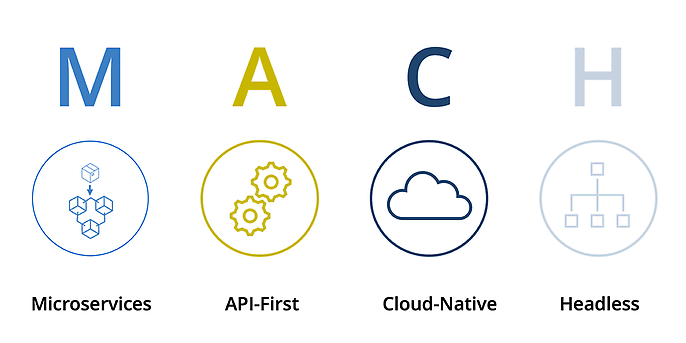
Why should you opt for these approaches?
The combination of headless commerce and composable architecture offers companies an agile and flexible basis for their e-commerce platforms. These approaches make it possible to react quickly to changing business requirements, create innovative user experiences and efficiently integrate third-party services.
Monolithic vs. headless: a revolution in e-commerce design
Conventional e-commerce systems are often characterised by a tight coupling of front-end and back-end. This changes with headless commerce. The idea behind this architecture is simple but powerful - the separation of frontend and backend. Why is that? Here are a few reasons:
Multichannel presence
With headless commerce, companies can present content across different channels. Whether on websites, mobile applications or even IoT devices - the flexible architecture enables seamless adaptation to different platforms.
User experience on a new level
The decoupling of the front end and back end gives developers the opportunity to create innovative user interfaces that meet the latest trends in design and user experience. Customisation to the specific requirements of different platforms becomes easier.
Independent updates
Front-end and back-end systems can be updated independently of each other. Fast iterations and updates are possible without changes in the frontend affecting the backend logic.
Simple integration of third-party providers
The flexible architecture facilitates the integration of third-party services and tools to provide additional functions or services.
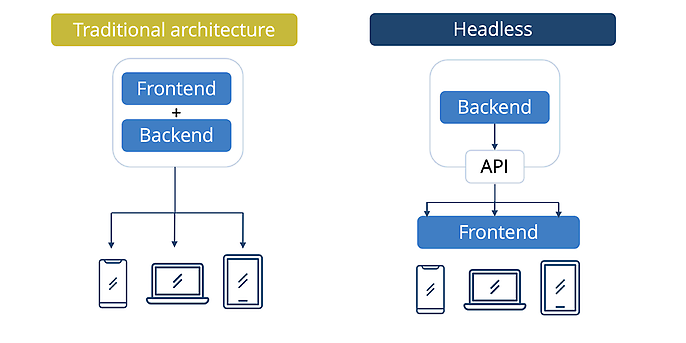
Composable architecture: the building blocks of innovation
Composable architectures enable flexible and future-proof utilisation of an e-commerce platform. This involves building an application from independent, composable modules or services. The advantages of this approach are manifold:
Modular design
The e-commerce platform is divided into different modules or services that fulfil specific functions. Each module is independent and can be developed, updated or replaced separately.
Agility and adaptability
Companies can react quickly to changing requirements. New functions can be added or existing modules replaced without affecting the overall system.
Optimised use of third-party services
The composable architecture enables the efficient integration of third-party services and APIs to provide specialised functions. SAP Commerce Cloud as a solution for B2B & B2C
The SAP Commerce Cloud is a comprehensive shop system that can be seamlessly integrated into the entire company infrastructure. As a cloud-native and API-based solution, the former Hybris e-commerce software now enables successful omnichannel commerce and offers comprehensive integrated functions for handling various business processes. The SAP Commerce Cloud is suitable for both B2B and B2C requirements. In addition, the SAP Commerce Cloud is specifically geared towards the special requirements of B2B business models. But how exactly can B2B business benefit from the SAP Commerce Cloud?
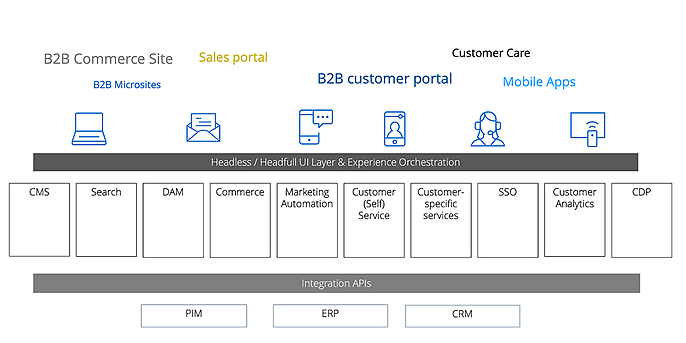
Standard integration
The option of standard integration into the customer's existing SAP landscape ensures a seamless and comprehensive connection between the individual components. The connection to the existing ERP system is particularly helpful in order to be able to take current price changes into account, for example. The interaction between SAP S/4HANA or SAP ECC as ERP and the modules of the SAP CX Suite enables complex business processes to be covered with a wide range of benefits. From ticketing and complaint management to communication with the SAP Sales and Service Cloud to real-time pricing and customised marketing communication with Emarsys. The centralised enrichment of customer data with the SAP Customer Data Platform and the SAP Customer Data Cloud enables a 360-degree view of the customer base. SAP integration takes place via the SAP Business Technology Platform (BTP). Thanks to the API-first approach, integration with other services is also possible without any problems.
System availability & complexity
The reliable availability of SAP Cloud Services ensures uninterrupted business operations and optimum performance even at peak times. With a downtime of less than one per cent this year, the SAP Commerce Cloud has been very well received by customers. The data model of the SAP Commerce Cloud impresses with its customisability and pre-configuration and thus meets even highly complex requirements. The shop system easily handles a high number of simultaneous page views or orders.
Product variant configuration and after sales
Another advantage, particularly in the manufacturing industry, is the possibility of differentiated product variants. Thanks to the interaction between SAP Commerce Cloud and SAP S/4 HANA (ERP), configuration models can be extracted from a large number of variants and displayed to the (end) customer in a comprehensible way in the front end. The user thus receives a true-to-configuration visualisation and guidance through the purchasing process. The SAP Commerce Cloud can also be used to cover after-sales processes. IoT integration via sensors enables defects in machines or the locking of individual parts, for example, to be recognised at an early stage. The system recognises which product part is involved and provides the customer with a corresponding purchase suggestion to quickly rectify the problem or prevent it from occurring in the first place. In this way, downtimes can be avoided.
Authorisation and budget management
The SAP Commerce Cloud offers additional functions such as budget allocation and account management. For example, rules can be assigned for shopping baskets if a product order has special requirements. Authorisation management can be based on business customer segmentation (e.g. by location or turnover).
Theory understood, but what does it look like in practice?
The following use case gives you an insight into the introduction and benefits of the SAP Commerce Cloud.
Initial situation
A company from the food and beverage industry (FMCG) was already using an on-premise ERP solution from SAP in its existing system landscape. adesso started the project with holistic consulting - including recommendations for action on the topics of marketing automation, tracking, customer loyalty and personalisation based on a workshop. To ensure success, SAP emarsys and the SAP Customer Data Cloud were initially introduced. A B2B service platform was also considered during implementation, so that the second part of the project could be started after successful implementation.
The all-round carefree package: SAP Commerce Cloud
The next project module was launched with the introduction of SAP Commerce Cloud as a shop platform. The use case required the centralised management of several B2B shops on one platform. The aim was to address different target groups and optimise operational processes. With the multi-shop functionality of the SAP Commerce Cloud, the resulting requirements could be implemented seamlessly and efficiently. Thanks to the API technology, communication between the individual shops ran smoothly. The scalable and high-performance cloud infrastructure ensured that the speed and availability of the shops always remained at the highest level, even with increasing requirements. In addition, the SAP Commerce Cloud not only offers a powerful administration interface, but also enables the integration of microservices and third-party applications. As an additional sales opportunity and to support sales, business customers should be able to place orders independently via the shop interface. The digitalisation of business processes and the improvement of communication with B2B customers emerged as further advantages.
The new website also needed to offer the option of placing product information and advertising in an appealing way. The SAP Commerce Cloud proved to be the right solution in this case, as it could be integrated perfectly into the customer's existing SAP system landscape thanks to its standard integration. The smooth communication between the SAP Commerce Cloud and the customer's SAP ERP meant that the integration effort and costs could be kept to a minimum. The project therefore promised good maintainability and high flexibility. The susceptibility to errors was also reduced to a minimum. The composable architecture of the SAP Commerce Cloud ensures a division into different modules or services, each of which fulfils specific functions. Each of these modules is independent and can be developed, updated or replaced independently. Another advantage of this architecture is the ability to react quickly.
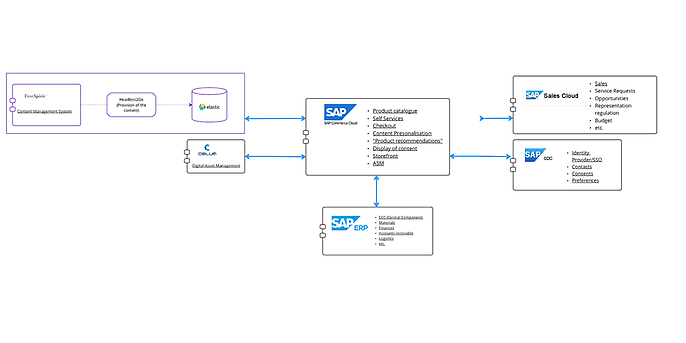
Move2Cloud as the basis for the success of your e-commerce with SAP
Anyone currently operating an SAP-based online shop on-premise should take action now and plan and implement the migration to the SAP Commerce Cloud. SAP is consistently focussing on cloud technologies in e-commerce and will make future enhancements to SAP Commerce available exclusively in the cloud. The end of mainstream maintenance for this release is set for 31 May 2024. Version 2205 is the last version available for download for on-premise installations. According to SAP, future innovations after this version will only be made available for cloud systems, which is why it makes sense to act early.
As an SAP Commerce Cloud customer, your company will benefit from a powerful infrastructure with excellent performance scalability, long-term support and innovations as well as a constantly growing integration of all SAP modules.
Migrate to the SAP Commerce Cloud with adesso
At adesso, we rely on a well thought-out and customised migration process to ensure that the changeover runs smoothly and successfully. Our aim is not only to bring your system up to date, but also to ensure that the new environment is optimally tailored to your requirements.
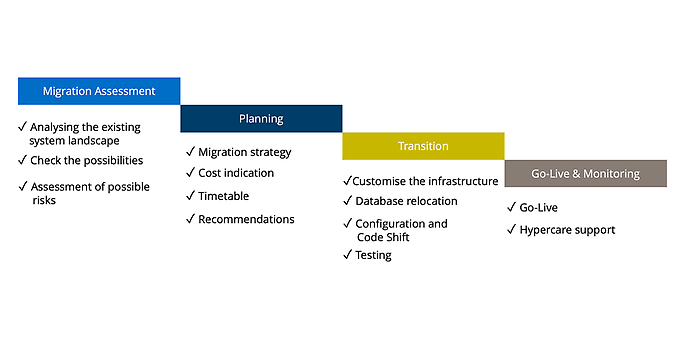
As an SAP expert partner with many years of experience, adesso offers the necessary expertise that companies need on their individual path to the cloud: from the initial analysis to data migration and subsequent operation. Discover the benefits of our Cloud Readiness Check for the SAP Commerce Cloud! By thoroughly analysing your current IT infrastructure, we help you to develop the optimal cloud strategy. Benefit from higher scalability, improved security standards and more agile business processes. Our tailored approach minimises risks, maximises efficiency and paves the way for a smooth digital transformation. Get started now and secure the key to a future-proof and sustainable business landscape.
Would you like to find out more about the solutions and services adesso offers in the SAP environment? Then take a look at our website or have a look at our other blog posts on the subject of SAP.
You can find more exciting topics from the world of adesso in our previous blog posts.

